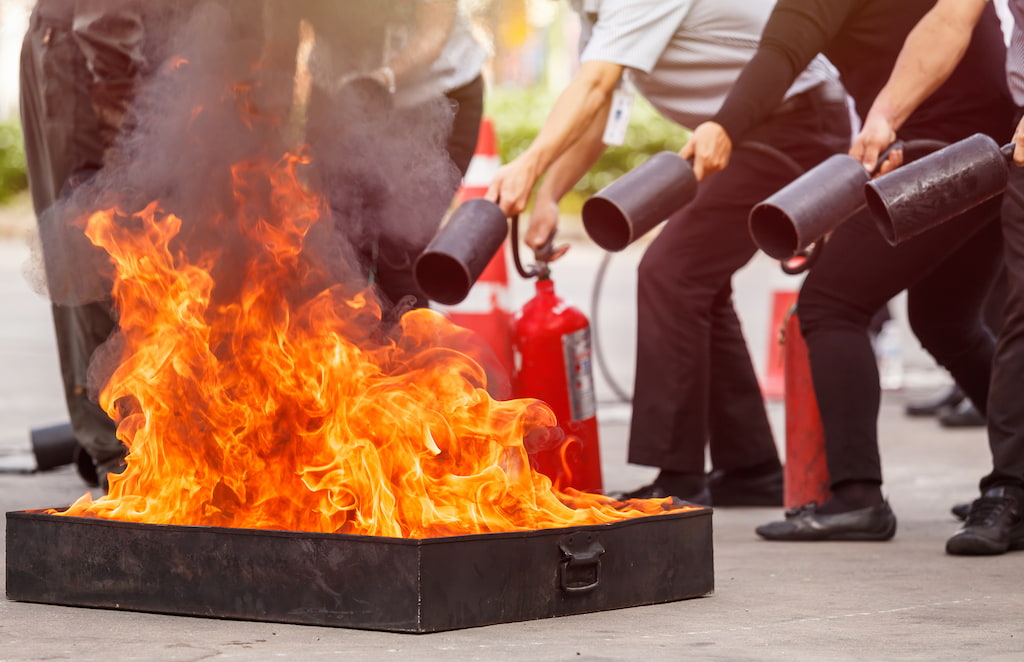What Are the Five Different Classes of Fire and How to Extinguish Them
July 19, 2022
Published by:
Andrew ArdiantoFire can have devastating effects on a structure and its occupants. But not all fires are the same, so how many classes of fire are there? There are five classifications of fire, all of which have their own origins and resulting damage. In this article, we’ll discuss the different fire types and how to take precautions against them.
What Are the 5 Different Classes of Fires?
So exactly how are fires organized into classes? The five classes are organized based on their fuel source:
- Combustible materials;
- Flammable liquids and gasses;
- Electrical;
- Metallic;
- Kitchen and food prep.
Class A Fires: Ordinary Combustible Materials
The most common type of fire, Class A fires are fueled by ordinary combustible materials. These Class A fuels include fabrics, paper, trash, wood, plastics, etc. These accidental fires are best put out with exactly what you would first think of water. They can, however, also be put out with monoammonium phosphate.
No matter how ordinary, do not assume these fires aren’t dangerous. They can intensify quickly with enough combustible material present, and can cause serious damage to properties and their inhabitants.
Class B Fires: Flammable Liquids and Gasses

Class B fires are fueled by flammable liquids and gasses, including:
- Propane;
- Methane;
- Gasoline;
- Kerosene;
- Paint.
As these materials are most often found in industrial settings, that’s where they are more likely to occur, but this does not negate the possibility of a Class B fire in a commercial or residential property.
Water disperses these substances, making it an ineffective option that will spread rather than control the fire. Class B fires need to be snuffed out— meaning oxygen must be removed completely. Monoammonium phosphate and sodium bicarbonate are commonly used for this.
Class C Fires: Electrical Fires
Electrical fires are Class C fires that most often occur in facilities with a lot of electrical equipment. This can include anything from a data center to a construction site; on a construction site, the power tools can cause sparks that will cause these fires. It’s important to note that electrical fires can also happen in residential or commercial buildings due to faulty wiring or even just an unattended space heater.
Water won’t put out an electrical fire, but disconnecting from the power supply and using non-conductive agents can.
Class D Fires: Metallic Fires

Of the different types of fire classes, Class D fires, or fire caused by combustible metals, can be particularly challenging. That’s because these metals have their own chemical properties that can potentially pose more risk. These metals include:
- Lithium;
- Potassium;
- Titanium;
- Magnesium;
- Aluminum, and more.
Class D fires most commonly occur in research and manufacturing facilities and laboratories, and are more likely to be an issue where metals are in powder form. Dry powder agents are used to putting out Class D fires as they block oxygen.
Class K Fires: Food Preparation and Kitchen Fires
When it comes to classes of fires, Class K is unique in its requirements. These fires occur during food preparation when putting butter, olive/cooking oils, lard, or grease overheat. These fires are not under Class B because they are specific to the restaurant industry and commercial kitchens (though they can occur in residential kitchens as well).
Class K fires, commonly referred to as grease fires, cannot be put out with water. They need to be smothered and doused with wet chemical extinguishers.
International Fire Classes (Europe & Australia)
How to Prepare for Different Fire Classes
Now that you know what are the five classes of fire, it’s essential to understand how to best prepare for their unfortunate occurrence.
Keep Up with Testing and Maintenance
Inspecting and maintaining equipment regularly can ensure that you are well protected from any of the five classes of fire. Check fire extinguishers and replace them after their expiration. Also, be sure that your fire suppression system, building capacity, and fire alarms are up to date with local fire codes.
Choose the Right Fire Extinguisher
In order to tackle each of the fire classes, it’s important to have all the necessary fire extinguishers. There are a few types of fire extinguishers: CO2, foam, powder, water, and wet chemical. Below is an easy table to reference.
Complete Regular Training
The different fire classes are best addressed when everyone in the building, facility, or site has proper fire safety training in advance. Knowing how to use extinguishing equipment and fire suppression systems, when and how to contact the proper authorities, and established evacuation plans will help ensure everyone stays safe.
Conclusion
If you’re ready to take your fire safety to the next level, speak with one of our fire protection engineers at MNA Quality today for expert guidance!
back to blog
Table of Contents
.svg)



